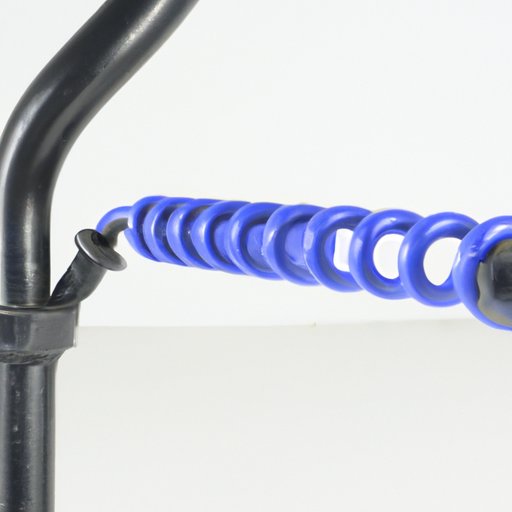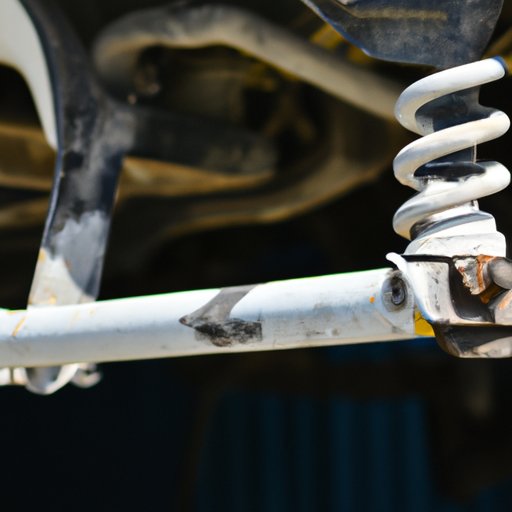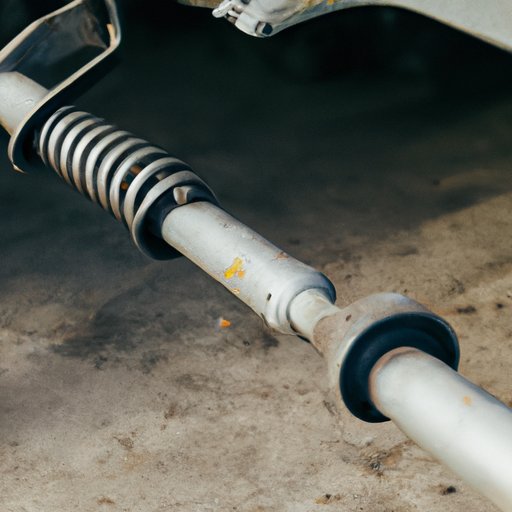Introduction
A sway bar, also known as an anti-roll bar or stabilizer bar, is a component of a suspension system found in most modern cars and trucks. Its purpose is to reduce body roll, which is the tendency of a vehicle to lean to one side during cornering or when crossing uneven surfaces. By connecting the left and right sides of the suspension, the sway bar helps to keep the vehicle more level while driving, thus enhancing its overall performance and safety.
In this article, we will explore the mechanics of how a sway bar works, and look at the science behind it. We will also discuss the different types of sway bars and their benefits, as well as examining the role of a sway bar in suspension systems.
Exploring the Mechanics of a Sway Bar: How Does it Work?
A sway bar consists of a metal rod that is connected to the left and right sides of the suspension. The bar is usually made of steel, though some vehicles may have aluminum or composite bars. The bar is attached to the vehicle chassis via two connecting mounts and brackets. These brackets are then connected to the suspension arms by bushings.
At the heart of the sway bar’s mechanism is a linkage system. This system consists of two levers that are connected to each other and to the sway bar. When the vehicle goes over a bump or around a corner, the levers move in opposite directions. This movement causes the sway bar to twist, which in turn transfers the force from one side of the suspension to the other. This helps to keep the vehicle level and stable, reducing body roll.
The connecting mounts and brackets play an important role in the sway bar’s mechanism. They provide a secure attachment point between the sway bar and the vehicle chassis, allowing the bar to transfer the forces from the suspension arms to the chassis. The bushings, meanwhile, allow the bar to move freely and absorb any vibrations or shocks that may occur.

The Science Behind a Sway Bar: An Overview
The physics behind a sway bar is relatively simple. When the vehicle goes over a bump or around a corner, the forces acting on the suspension arms cause them to move in opposite directions. This movement causes the sway bar to twist, transferring the force from one side of the suspension to the other. This in turn helps to keep the vehicle level and stable, reducing body roll.
The forces acting on a sway bar can be broken down into two components: vertical and lateral. The vertical force acts along the length of the bar, while the lateral force acts perpendicular to the bar. The vertical force helps to keep the vehicle level, while the lateral force helps to reduce body roll. The combination of these two forces helps to keep the vehicle stable and improve its overall performance.
What is a Sway Bar and How Does it Improve Your Vehicle’s Performance?
A sway bar helps to keep the vehicle more level while driving, thus enhancing its overall performance and safety. It does this by connecting the left and right sides of the suspension, allowing the bar to transfer forces from one side of the suspension to the other. This in turn helps to reduce body roll and keep the vehicle more stable.
The installation of a sway bar can also help to improve the vehicle’s handling. By connecting the left and right sides of the suspension, the bar helps to reduce body roll, thus allowing the driver to maintain better control of the vehicle. This in turn can help to improve the vehicle’s overall performance and safety.

Understanding the Role of a Sway Bar in Suspension Systems
A sway bar is an integral part of a vehicle’s suspension system. It connects the left and right sides of the suspension, allowing the bar to transfer forces from one side of the suspension to the other. This helps to reduce body roll and keep the vehicle more level while driving, thus enhancing its overall performance and safety.
There are several different types of suspension systems, each with its own unique components. In general, these systems consist of shock absorbers, springs, and sway bars. Shock absorbers help to reduce the impact of bumps and road irregularities, while springs provide additional support. The sway bar, meanwhile, helps to reduce body roll and keep the vehicle more level while driving.
A Comprehensive Guide to Sway Bars and Their Benefits
Sway bars are a vital component of most modern vehicle suspension systems. By connecting the left and right sides of the suspension, they help to reduce body roll and keep the vehicle more level while driving. This in turn can improve the vehicle’s overall performance and safety.
There are several different types of sway bars, each with its own set of benefits. Heavy-duty sway bars are designed to provide greater stiffness and improved handling, while lightweight bars are designed to reduce body roll and improve overall ride comfort. There are also adjustable sway bars, which allow drivers to adjust the stiffness of the bar according to their personal preference.
Installing a sway bar can also help to improve your vehicle’s performance. With a properly installed sway bar, you can expect improved handling, increased stability, and reduced body roll. All of these factors can help to make your vehicle safer and more enjoyable to drive.
Conclusion
Sway bars are a key component of most modern vehicle suspension systems. They connect the left and right sides of the suspension, allowing the bar to transfer forces from one side of the suspension to the other. This helps to reduce body roll and keep the vehicle more level while driving, thus enhancing its overall performance and safety.
There are several different types of sway bars, each with its own set of benefits. Installing a sway bar can also help to improve your vehicle’s performance, providing improved handling, increased stability, and reduced body roll. Ultimately, a sway bar is an essential component of any vehicle’s suspension system and can make a big difference in terms of performance and safety.
Summary of Key Points
- A sway bar is a component of a vehicle’s suspension system that helps to reduce body roll and keep the vehicle more level while driving.
- The mechanism of a sway bar consists of two levers that are connected to each other and to the sway bar.
- The forces acting on a sway bar can be broken down into two components: vertical and lateral.
- Installing a sway bar can help to improve the vehicle’s performance and safety.
- There are several different types of sway bars, each with its own set of benefits.
Final Thoughts
Sway bars are an essential component of any vehicle’s suspension system. They help to reduce body roll and keep the vehicle more level while driving, thus enhancing its overall performance and safety. Installing a sway bar can also help to improve your vehicle’s performance, providing improved handling, increased stability, and reduced body roll.
(Note: Is this article not meeting your expectations? Do you have knowledge or insights to share? Unlock new opportunities and expand your reach by joining our authors team. Click Registration to join us and share your expertise with our readers.)
